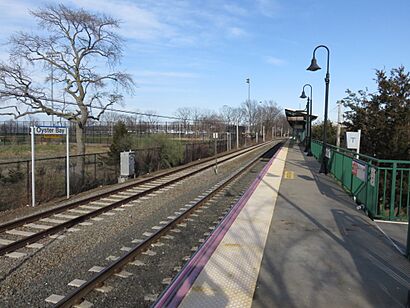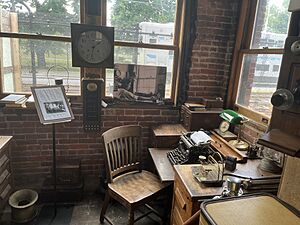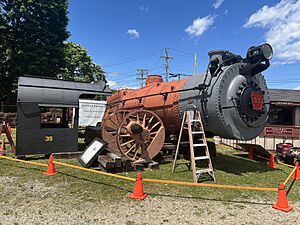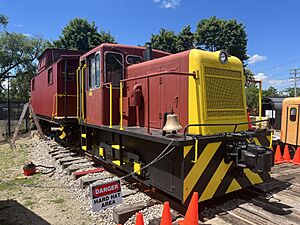Oyster Bay station facts for kids
Quick facts for kids
Oyster Bay
|
|||||||||||||
|---|---|---|---|---|---|---|---|---|---|---|---|---|---|

The Oyster Bay station, as seen in 2016
|
|||||||||||||
| Location | Shore & Maxwell Avenues Oyster Bay, NY |
||||||||||||
| Owned by | Long Island Rail Road Town of Oyster Bay |
||||||||||||
| Line(s) | Oyster Bay Branch | ||||||||||||
| Distance | 32.9 mi (52.9 km) from Long Island City | ||||||||||||
| Platforms | 1 side platform | ||||||||||||
| Tracks | 2 | ||||||||||||
| Connections | Oyster Bay Taxi | ||||||||||||
| Construction | |||||||||||||
| Parking | Yes; Free | ||||||||||||
| Other information | |||||||||||||
| Fare zone | 7 | ||||||||||||
| History | |||||||||||||
| Opened | June 24, 1889 | ||||||||||||
| Rebuilt | 1902 | ||||||||||||
| Traffic | |||||||||||||
| Passengers (2006) | 225 | ||||||||||||
| Services | |||||||||||||
|
|||||||||||||
|
|||||||||||||
|
Oyster Bay Long Island Rail Road Station
|
|||||||||||||
| Location | Railroad Avenue, Oyster Bay, New York, USA |
||||||||||||
| Architectural style | Tudor Revival | ||||||||||||
| NRHP reference No. | 05000666 | ||||||||||||
| Added to NRHP | July 6, 2005 | ||||||||||||
The Oyster Bay train station is the very last stop on the Oyster Bay Branch of the Long Island Rail Road. It is located in Oyster Bay, New York. The station has a raised concrete platform. This platform stands near the original station building. Both the old and new stations are next to Theodore Roosevelt Memorial Park. You can't catch a bus here, but local taxis are available.
Contents
About the Oyster Bay Station
The first Oyster Bay station opened on June 24, 1889. It was updated in 1902. There were once plans to make the train line go even further east. A large pier was also built here. This pier helped load train cars onto a ferry. The ferry went to Wilson's Point in Connecticut. Today, the Flowers Oyster Company owns this pier.
The old Oyster Bay Station and its Oyster Bay Long Island Rail Road Turntable are important historical sites. They were both added to the National Register of Historic Places on July 6, 2005. People are working to turn the old station into a railroad museum.
History of the Station
On June 24, 1889, a company called the Oyster Bay Extension Railroad finished building the train line to Oyster Bay. They built a beautiful Victorian style train station. The land for the station was given by Colonel Robert Townsend. At first, eight trains traveled back and forth from Long Island City each day. The original station had a big wooden platform. It also had a fancy covered porch called a porte cochere. This porch was big enough for horse-drawn carriages to drive through.
In 1891, the Long Island Rail Road built a long wharf, about 1,000 feet (305 meters) long. This connected the land to the sea. It allowed train cars full of passengers to be loaded onto a ferry. The ferry was named the Cape Charles. It took passengers to Connecticut. From there, they could connect to other railways and travel to Boston. This special train-to-ferry service from New York to Boston stopped when a land route across Connecticut was built.
On September 9, 1891, a train engine exploded at the station. It was waiting for passengers. People as far away as East Norwich felt the blast. Sadly, three crew members died.
When Theodore Roosevelt became the head of the New York City Police Board in 1895, he often traveled through this station. When he became President of the United States in 1901, big plans were made to expand the station. This was to handle more visitors coming to the area. The station was renovated in 1902. The covered porch was removed. Long weather sheds, about 400 feet (122 meters) long, were added. Inside, a large fireplace was installed. Outside, a special stucco was used that had real oyster shells in it.
The architect who designed the 1902 renovations was Bradford Lee Gilbert. He also designed updates for Grand Central Station in 1898.
By the end of the 1900s, the station started to fall apart. A new station and platform were built nearby. This new platform could handle bigger, double-decker trains.
The Railroad Museum
The Oyster Bay Railroad Museum is a non-profit group. They are working to create a museum at the old station. The Town of Oyster Bay now owns the original LIRR Oyster Bay station. It used to belong to the Long Island Rail Road. Many studies have been done to help restore the old building. The Oyster Bay Railroad Museum has turned the original station into its new home.
The original station is open on weekends from April to November. It is one of two locations for the museum. The other is an outdoor yard and turntable site. This is a short walk from the station in Theodore Roosevelt Park. Visitors can explore three train cab simulators. These were given to the museum by the Long Island Rail Road. They are based on different train models. As of October 2024, volunteers got the LIRR M7 Simulator working with special software. As of March 2025, the DE30AC Simulator is being restored to work again.
Since 2022, many improvements have been made at the Oyster Bay Turntable site. Three new tracks have been built in the yard. A classic LIRR "Ping Pong" Coach train car is being restored. It was once used on a railroad in Pennsylvania. The museum's main focus is restoring former Long Island Rail Road steam locomotive #35. They are raising money to fix its parts. The museum is also planning to offer train rides. A GE 25 Ton Diesel Switcher, which was LIRR #398, has been restored. It will be used for future train rides. This engine is planned to be renumbered 26. This is to honor Theodore Roosevelt, who was the 26th US President. A 1927 Long Island Rail Road caboose, #12, will carry passengers. The train rides will use the restored 1902 turntable. As of March 2025, the museum is also getting ready to build an "escape track." This will help with train ride operations. It will also allow locomotive #35 to be moved around the tracks.
Station Design
This station has one platform that is raised high. It is long enough for four train cars. The platform is next to the south track. The north track is a passing track. It joins the south track and leads to a seven-track yard just past the station. The old station building is just east of the new station. Theodore Roosevelt Memorial Park is just north of the tracks.
| Track 1 | ← Oyster Bay Branch toward Long Island City or Penn Station (Locust Valley) |
| Side platform, doors will open on the left or right |
|
The Turntable
|
Oyster Bay Long Island Rail Road Turntable
|
|

Oyster Bay Station Turntable (behind chainlink fence).
|
|
| Location | 40°52′29.8″N 73°31′42.9″W / 40.874944°N 73.528583°W Railroad Avenue, Oyster Bay, New York, USA |
|---|---|
| Built | 1902 |
| NRHP reference No. | 05000667 |
| Added to NRHP | July 6, 2005 |
Oyster Bay has one of the few remaining Long Island Rail Road stations with an original turntable. A turntable is a large spinning platform that turns train engines around. This turntable was built in 1902. It replaced an older, smaller one. The turntable is listed on the National Register of Historic Places. It is also a Town of Oyster Bay Landmark. You can learn about it on the Oyster Bay History Walk audio tour.
See also





